What Is ICM in Poker: Ben Rolle Explains

- Fact Checked by: PokerListings
- Last updated on: January 29, 2025 · 4 minutes to read
You can’t be successful in poker if you don’t know how to use mathematics to gather more information. One of the ways to do so is using the Independent Chip Model (ICM) to make calculations for tournaments. It can be done effectively only when you understand the purpose and mechanics of this. As a good poker coach does, Ben Rolle decided to explain ICM in simple words for everyone on X (ex-Twiiter) — and PokerListings retell his thread in this article.
What Is ICM In Poker & Why It Matters?
The Independent Chip Model is a mathematical method of calculating the value of your chips in tournaments. Ben Rolle explains it in more detail:
“ICM (Independent Chip Model) is a way to calculate the real-world value of your stack in a poker tournament. Tournament chips don’t equal cash directly; their value depends on your chances of winning prizes. ICM assigns each stack a value based on its potential to finish in different payout positions.
It helps you understand how much your chips are “worth” in terms of prize money. This is especially important near big moments like the bubble or final table.”
So, the Independent Chip Model helps players to calculate monetary value of their stacks at different stages of tournaments and in various situations depending on other players’ stacks.
For example, Ben suggests to imagine three scenarios in a tournament:
- You start a $100 tournament with 5K chips, but lose all of them except 10 chips.
- You are at the stone bubble — one player away from a prize zone — and have only 10 chips.
- You are in the money with only 10 chips.
These situations can seem similar but in reality the value of these 10 chips varies significantly, as Ben says:
“Early on, those 10 chips are almost worthless, probably not even a cent.
Assuming a tiny chance of making it in the money, your stack might still be worth cents or even dollars.
If you are in the money, your 10 chips are worth over $100.”
So, ICM gives you a way to calculate the exact value of your stack and give you more information for the decision-making process. It also helps you to adjust ranges in different scenarios.
ICM At Different Stages Of Poker Tournament
The Independent Chip Model is valid at any stage of poker tournaments. It has less significance as a factor in the decision-making process in early stages, when chips have a lower value, but becomes more significant in later stages when the value of each chip changes.
Example #1: ICM on Preflop when 80-90% of the Field Left
Ben chooses a 1,000 field tournament with 90% players remaining. Average stack is 50 bb. We face a 3bet from HJ vs CO.
The ChipEV model here shows that we need to fold 43% hands.
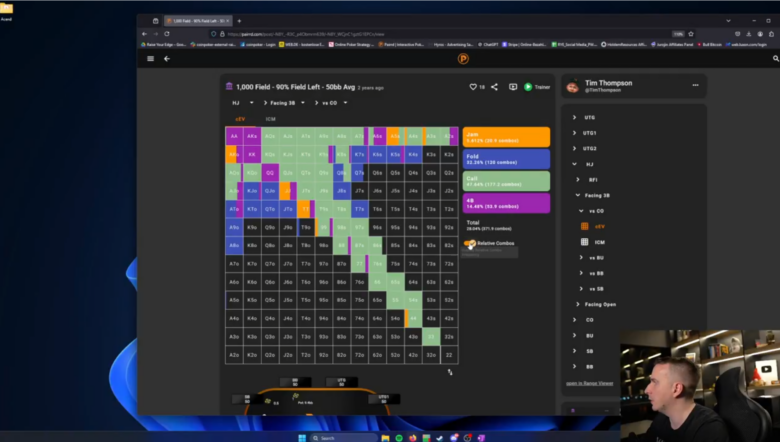
At the same time, according to ICM we need to fold 40% here.
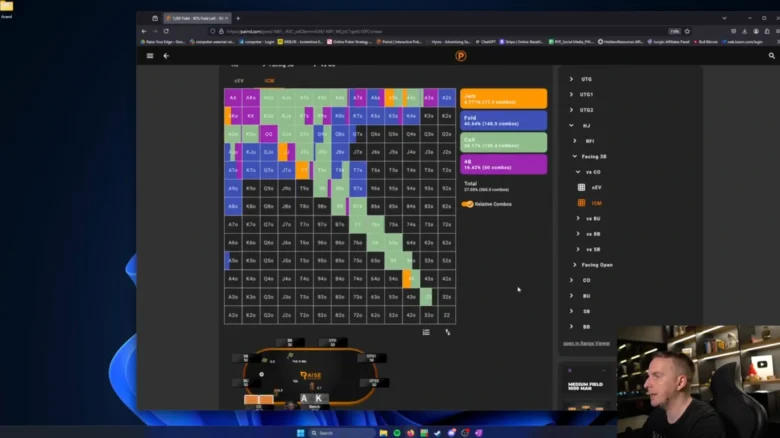
Folding is just the prime example of ICM significance here but if you look closely at screenshots from Rolle, you will see that ICM affects the whole range for every decision.
Example #2: ICM on Preflop with 33-50% of the Field Left
Another 1,000 field tournament from Ben, but there is 30% of the field left and average stack is 40 bb. Scenario is the same: we face 3bet from HJ vs CO.
ChipEV here shows that we need to fold almost 34% of our range.
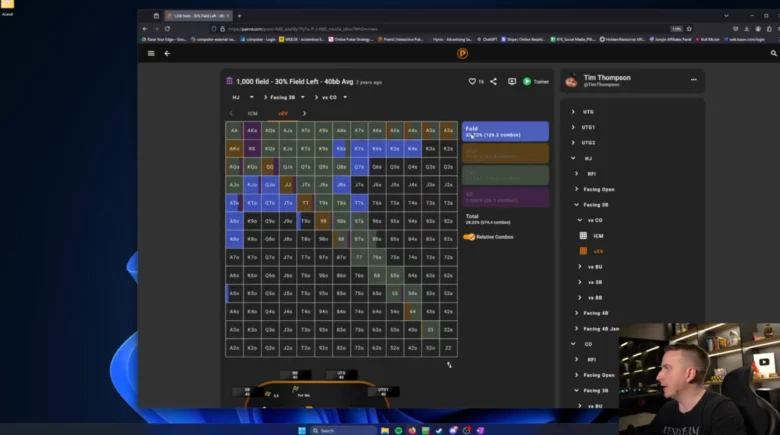
The ICM gives a much tighter range with almost 64% to fold.
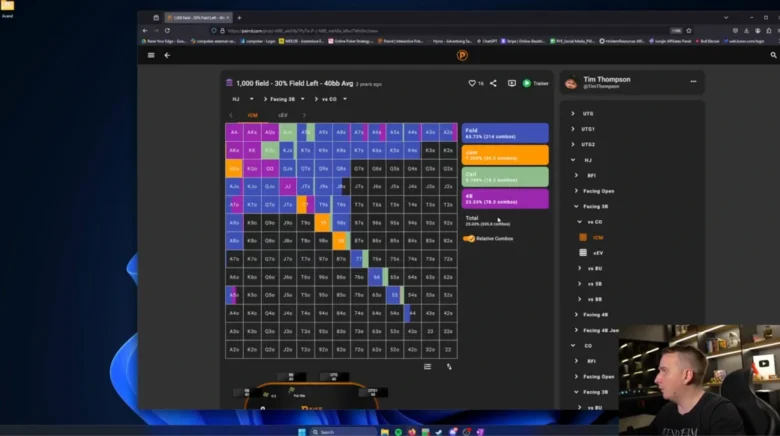
However, considering ICM here we should play more aggressive — jam or 4-bet more than 30% of the range versus 19% according to the ChipEV model.
Example #3: ICM on the Bubble as a Midstack
This time here is the bubble of a 250 entries field tournament with an average stack size of 20 bb.
CO open jams with an effective stack of 20 bb and we have a 17 bb stack on BB.
What should we do? Well, according to the ICM we need to call around 9% of our range.
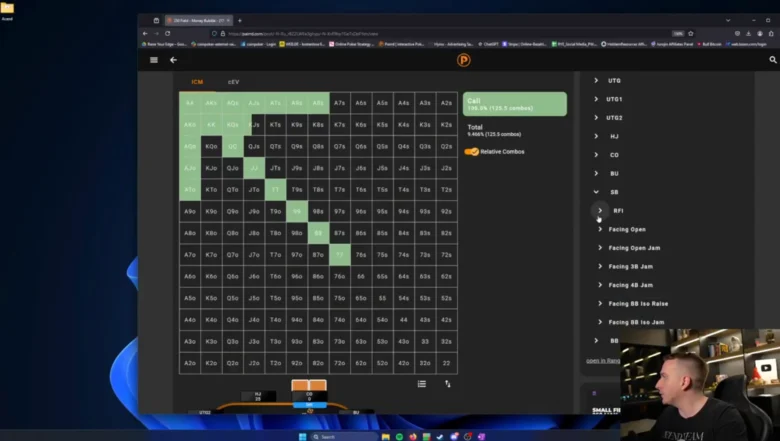
For comparison, a player on the SB. who has a 15 bb stack, need to call tighter in this situation — only 8.5% of their range.
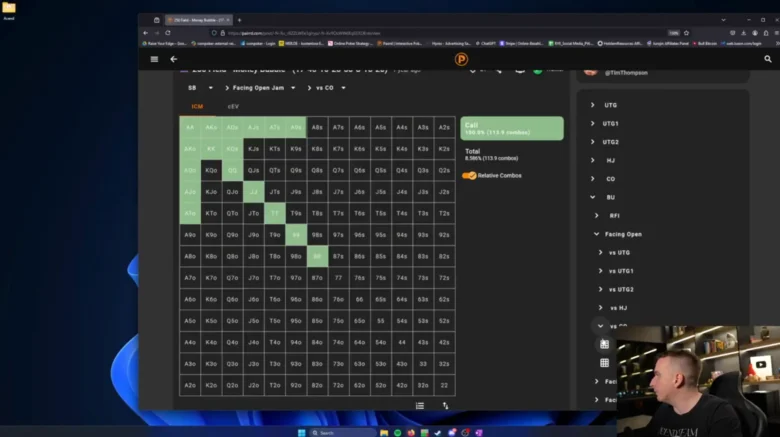
Curiously, a player on the BU with a 20 bb stack needs to be even tighter with only 7.5% of their range.
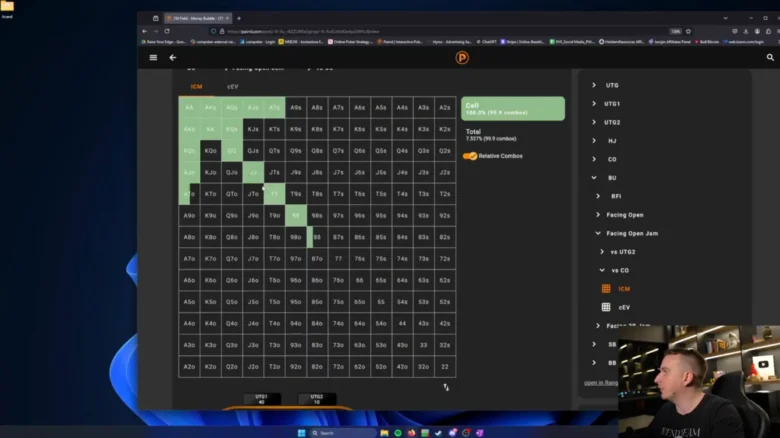
The differences between ranges here Ben explains simply:
“ICM always calculates the risk/reward. If your reward is doubling up and putting yourselves in a tremendously beneficial position, then you also risk your Tournament Life at very HIGH ICM situations with “weaker” holdings (against what most people believe to be correct), i.e., AQ, AJ, etc.”
It is worth remembering that ICM there is a “GTO ICM” — it means that it doesn’t consider specific factors, opponents tendencies and pacing of each individual event. But you should adjust to your situation instead of discarding it.
Last Pieces Of Advice On ICM From Ben Rolle
- You can “fold your way” into the money when doubling up is not really beneficial for you, often with 8-15bb stacks, you are not gaining a lot by doubling up, but you risk making it in the money.
- Early, up to 75% left, you should play a more chEV-oriented approach.
- From 75%-50% left, you should already consider ICM applications against bigger stacks.
- From 50%-33%, you should start implementing more ICM concepts, such as less flatting, more 3betting, and more 4betting.
- From the 33% to the Money bubble, you should follow a more ICM-heavy approach.
Ben warns you to be very careful and thoughtful while considering ICM:
“Overall, it’s a tighter yet more aggressive approach, but keep an eye on spots where you get away with playing a lot of hands (due to bad/weak opponents).”
More information about ICM:
-
Stake.US Poker4.3
- Rakeback 5%
- $55 Stake Cash + 260K Gold Coins
T&Cs Apply | Play Responsibly | GambleAware
18+ | Play Responsibly | T&C Apply
-
Appeak Poker4.1
- 1,000 Chips Daily
- FREE 5,000 Chips
T&Cs Apply | Play Responsibly | GambleAware
T&Cs Apply | Play Responsibly | GambleAware
-
- 150% up to 25 SC
T&Cs Apply | Play Responsibly | GambleAware
Terms & Conditions apply
-
- 5%
- 200% Gold on 1st Purchase
T&Cs Apply | Play Responsibly | GambleAware
Terms & Conditions apply
-
- 2,500 Gold Coins + 0.50 Sweeps Coins
T&Cs Apply | Play Responsibly | GambleAware
18+ | Play Responsibly | T&C Apply
